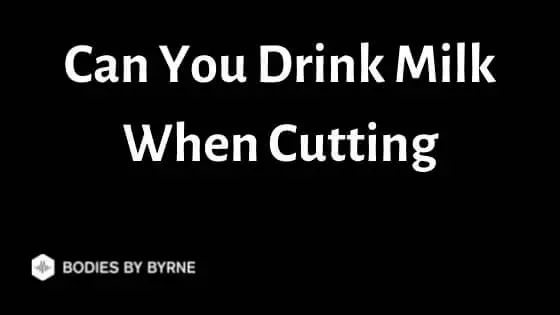When looking into what types of food you can consume during a cut, it’s very easy to neglect any liquid-based calories.
For most people (in my opinion) liquid calories in the form of drinks, sauces etc.. are subtle additions that can quickly – and unexpectedly – push people out of their deficit and into a calorie surplus.
I’ve recently covered whether you can drink diet soda when cutting as the calorie difference between diet soda and full fat soda can easily be 50kcals over just a few cans per day!
One prime example of this is milk. Most people will have milk with coffee, protein shakes, cereal, and a range of other foods without giving much consideration to how many calories they consume as a result.
In this article, I’ll therefore cover the neglected topic of can you drink milk when cutting to see if this food/drink choice will impact your cut or if there are any better alternatives.
Table of Contents
Can You Drink Milk When Cutting
You can drink milk when cutting if you maintain a calorie deficit. However, it’s recommended that you reduce cow’s milk consumption or have milk alternatives when cutting, because cow’s milk has a high carbohydrate and sugar content which can spike blood sugar levels, leading to cravings.
What Is Milk
Milk is a popular liquid food that comes from mammals like cows, sheep, and goats. It’s a big part of our diet in its raw form in things like coffee or cereal, and as a component in other foods (called milk products) like cheese, butter, and yogurt.
Check out this video on the significance of milk and some popular beliefs about it:
As milk is such a staple in our diets it’s an important food to think about when cutting.
Cow’s milk is the most popular and comes with different fat contents. As it’s the most popular it’s the one I’ll be paying the most attention to here. But other types of milk and milk alternatives like soya milk, oat milk, and pea milk, are still relevant and good to compare with.
To begin with, it’s good to look at the nutritional information for one portion (one cup/240ml) of 3.25% fat cow’s milk:
| Calories (kcal) | 149 |
| Protein | 7.7 grams |
| Fat | 8 grams |
| Carbohydrates | 11.7 grams |
| Sugar | 12.3 grams |
(Source 1)
Milk is a good source of protein and contains other important vitamins and minerals like calcium and B12 which are important for good general health.
Although the fat content and calories will change depending on what fat percentage milk you drink, cow’s milk still has a high carbohydrate and sugar content. This can make it a bad choice when cutting, which I’ll now explain.
Is Milk Bad When Cutting
Milk is not a good option when cutting. Although it has key nutrients which are important for a healthy diet, liquid calories aren’t as satisfying or filling as solid ones. So, consuming milk won’t leave you feeling full which isn’t ideal when cutting.
The reverse is true for bulking though and liquid calories in the form of milk is a great option for those with a low appetite.
Also, as I mentioned, cow’s milk is high in carbohydrates and sugar. This can lead to a spike in blood sugar levels, causing cravings, which isn’t good when you’re trying to maintain a calorie deficit.
There’s some debate around this because cow’s milk scores low on the Glycemic Index. This means that it doesn’t spike blood sugar levels as much as other foods with high carbohydrate or sugar content. However, cow’s milk is still high in carbs and sugar so can still lead to cravings. So, it’s often recommended that you should reduce your intake of cow’s milk when cutting.
Can I Drink Milk and Still Lose Weight
If you want to consume cow’s milk when cutting then it’s important to record your calories and maintain an overall calorie deficit.
You could also try milk alternatives.
There are so many different milk alternatives on the market today. Ultimately, you’re going to want a milk alternative that works for your cutting goals but still tastes good. My recommendation would be to try some of the different alternatives I’m going to discuss and see what works best for you.
If you do try milk alternatives then my advice is to look at labels. Lots of companies will add sugar to these alternatives to give them a longer shelf-life. Added sugars are going to increase calories and lead to cravings, so make sure you pick products without added sugar.
Different Milk Alternatives When Cutting
Here I’ve discussed some of the most popular milk alternatives and the best choices when cutting:
- Soy milk
Soy milk is made from soybeans, which are a great source of protein. Nutritionally, soy milk isn’t that different from cow’s milk, but it is lower in calories especially if it’s not been sweetened with sugar.
Although it’s one of the most popular cow’s milk alternatives, soy milk still has a high carbohydrate content which can have the same blood sugar spiking effect as cow’s milk. So even though it’s lower in calories, I wouldn’t recommend this when cutting.
- Oat milk
Oat milk is another popular alternative. It’s a good option when cutting if you’re looking for something that’s going to keep you fuller for longer, not just reduce calories. This is because oat milk contains fiber which slows digestion and leaves you feeling fuller for longer, helping to reduce cravings.
The only downside to oat milk is that in comparison to other plant-based milk alternatives it does have a higher carbohydrate content, but it’s still lower than that in cow’s milk.
- Almond milk
Another popular choice is almond milk which is made by soaking and blending almonds. It’s a great alternative to cow’s milk when cutting because it’s far lower in calories at 40kcal per portion (8oz), while still containing vital vitamins and minerals found in cow’s milk.
Almond milk is also much lower in carbohydrates compared with cow’s milk which again makes it an ideal alternative when cutting.
- Cashew milk
Similar to almond milk, cashew milk is made from soaking and blending cashews. It’s the lowest calorie option at 25kcal per portion and it’s lower in carbohydrate content at around 1gram. This makes cashew milk a great alternative when cutting.
The only downside is that cashew milk doesn’t seem to be as popular, so it can be slightly harder to find in stores, although it is available online.
- Pea milk
Pea milk is usually made by blending peas and combining them with oils and water. It’s lower in calories than cow’s milk at around 70kcal per portion. It’s also one of the lowest in carbohydrate content, with virtually no carbs.
Another advantage of pea milk is that it’s higher in protein at 8grams than a lot of other plant-based milk alternatives, as well as having other key vitamins and minerals.
Because of the low calorie and carb content, pea milk is a great alternative to cow’s milk when cutting.
What Is the Best Milk For Cutting
When drinking milk on a cut, the most important factor is calorie control. Milk is arguably one of the few food types that can be impacting people’s weight loss goals the most (without you realizing or knowing about it).
- Black coffee? Great for a cutting phase.
- Caffe latte or cappuccino? Added calories that you’ve maybe not tracked or even considered.
While you can make any type of milk fit your cutting diet, provided your track your macros and still maintain a calorie deficit, some options are going to make it harder than necessary. Full fat milk or oat milk as an example are both high-calorie options with a high fat/carb (or both) content.
Therefore, when cutting my recommendation would be to choose a low-calorie option with the most favorable macro ratios. A personal preference of mine would be pea milk as this is both low calorie and low carb compared to other types of milk (though not necessarily the lowest in both categories).
I’ve been using Sproud pea milk which I’d recommend for anyone looking for low-calorie milk alternatives. You can buy Sproud on Amazon here.

Final Thoughts
As with most things, not food groups are truly off-limits when cutting, it all comes down to calorie/macro management. Ensure you are in a calorie deficit whilst still getting a favorable macro ratio split and you’ll reap the rewards when it comes to body composition.
There’s no denying, however, that certain food choices are worse than others when cutting. The macro ratios for non-calorie dense foods are usually poor so food selection is not just about hitting a calorie deficit.
When it comes to milk, you’ll find it’s quite a high-calorie food (though you may not have suspected this when adding it to your morning coffee) and while you can fit it into your cutting diet, it limits you in other areas as a result.
For this reason, it’s good to look into milk alternatives instead which are lower in calories, carbs, or fats and will save precious calories for more nutrient-dense and satiating foods which are definitely needed the deeper you get into a cutting phase.
